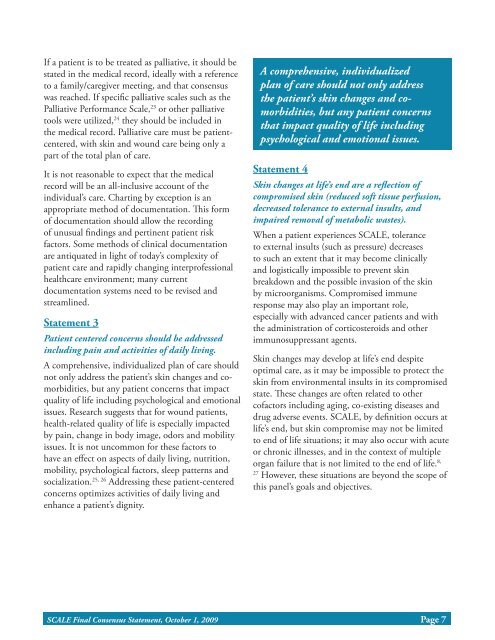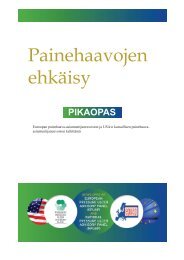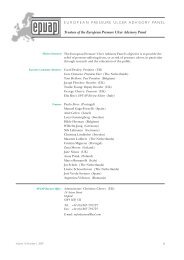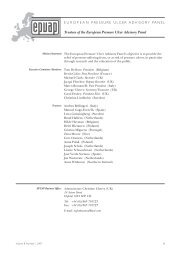SCALE Final Consensus Statement - European Pressure Ulcer ...
SCALE Final Consensus Statement - European Pressure Ulcer ...
SCALE Final Consensus Statement - European Pressure Ulcer ...
Create successful ePaper yourself
Turn your PDF publications into a flip-book with our unique Google optimized e-Paper software.
If a patient is to be treated as palliative, it should be<br />
stated in the medical record, ideally with a reference<br />
to a family/caregiver meeting, and that consensus<br />
was reached. If specific palliative scales such as the<br />
Palliative Performance Scale, 23 or other palliative<br />
tools were utilized, 24 they should be included in<br />
the medical record. Palliative care must be patientcentered,<br />
with skin and wound care being only a<br />
part of the total plan of care.<br />
It is not reasonable to expect that the medical<br />
record will be an all-inclusive account of the<br />
individual’s care. Charting by exception is an<br />
appropriate method of documentation. This form<br />
of documentation should allow the recording<br />
of unusual findings and pertinent patient risk<br />
factors. Some methods of clinical documentation<br />
are antiquated in light of today’s complexity of<br />
patient care and rapidly changing interprofessional<br />
healthcare environment; many current<br />
documentation systems need to be revised and<br />
streamlined.<br />
<strong>Statement</strong> 3<br />
Patient centered concerns should be addressed<br />
including pain and activities of daily living.<br />
A comprehensive, individualized plan of care should<br />
not only address the patient’s skin changes and comorbidities,<br />
but any patient concerns that impact<br />
quality of life including psychological and emotional<br />
issues. Research suggests that for wound patients,<br />
health-related quality of life is especially impacted<br />
by pain, change in body image, odors and mobility<br />
issues. It is not uncommon for these factors to<br />
have an effect on aspects of daily living, nutrition,<br />
mobility, psychological factors, sleep patterns and<br />
socialization. 25, 26 Addressing these patient-centered<br />
concerns optimizes activities of daily living and<br />
enhance a patient’s dignity.<br />
A comprehensive, individualized<br />
plan of care should not only address<br />
the patient’s skin changes and comorbidities,<br />
but any patient concerns<br />
that impact quality of life including<br />
psychological and emotional issues.<br />
<strong>Statement</strong> 4<br />
Skin changes at life’s end are a reflection of<br />
compromised skin (reduced soft tissue perfusion,<br />
decreased tolerance to external insults, and<br />
impaired removal of metabolic wastes).<br />
When a patient experiences <strong>SCALE</strong>, tolerance<br />
to external insults (such as pressure) decreases<br />
to such an extent that it may become clinically<br />
and logistically impossible to prevent skin<br />
breakdown and the possible invasion of the skin<br />
by microorganisms. Compromised immune<br />
response may also play an important role,<br />
especially with advanced cancer patients and with<br />
the administration of corticosteroids and other<br />
immunosuppressant agents.<br />
Skin changes may develop at life’s end despite<br />
optimal care, as it may be impossible to protect the<br />
skin from environmental insults in its compromised<br />
state. These changes are often related to other<br />
cofactors including aging, co-existing diseases and<br />
drug adverse events. <strong>SCALE</strong>, by definition occurs at<br />
life’s end, but skin compromise may not be limited<br />
to end of life situations; it may also occur with acute<br />
or chronic illnesses, and in the context of multiple<br />
organ failure that is not limited to the end of life. 8,<br />
27<br />
However, these situations are beyond the scope of<br />
this panel’s goals and objectives.<br />
<strong>SCALE</strong> <strong>Final</strong> <strong>Consensus</strong> <strong>Statement</strong>, October 1, 2009 Page 7
















